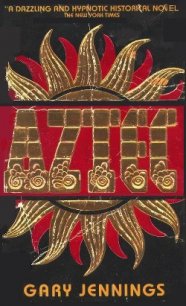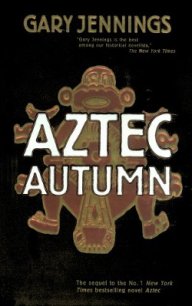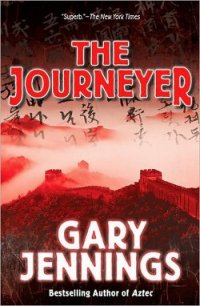Aztec Blood - Jennings Gary (книги онлайн бесплатно серия .txt) 📗
"The thief already has his head through the ring, he did that when he slipped into our camp to steal my pipe. Now we shall see if instead of backing out of the ring, he takes the tobacco."
We left our camp for the cacique's hut, where those requiring the Healer's services had gathered. After an hour I went back to the camp under the pretense of getting something. The tobacco was gone. I ran and told the Healer.
Moments later the cacique ordered every person in the village out into the street and instructed them to hold up their hands.
One man had red powder on his hands. We found the pipe under the straw bedding in his hut.
We left the thief to his fellow villagers for punishment. I got another lesson in the Aztec Ways when the Healer explained how a punishment would be devised.
"Our people believe that a crime should be punished with the same instrument that the crime was committed with. If a man murders another with a knife, the killer will be stabbed with a knife, the same one if possible; that returns the evil the killer gave to the knife back to the killer himself."
Tobacco theft presented a less clear choice of punishment than murder. I wondered what punishment the cacique and village elders would devise.
They consulted in a circle while they drank pulque—and smoked the ever-present tobacco, of course.
Finally, they came to a conclusion.
The thief was tied to a tree and a cloth sack placed over his head. A small hole was cut in the sack and one by one the men of the village went up to the sack with their burning pipes and blew smoke into the hole.
At first I heard the tied man coughing. The coughing became a gasping hack. When it began to sound like a death rattle, I left and returned to our camp.
FIFTY
I was to learn that there was a dark side to Aztec magic, a side as gruesome and bloody as anything imagined by Huitzilopochtli, evil so perverse, it was uncontrollable, even by the wielders. The fray used to accuse me of finding trouble like a bee finds pollen. Because of the tragic consequences that would follow, this was a time when I wished that I had not found trouble.
My introduction to the dark side of magic came when I encountered someone else I had also met at the treasure fleet fair.
We had come to a small town during the time of dia de los muertos, the Day of the Dead festivities. This was a day the indios remembered their dead with food and drink and much gaiety in the cemetery where their dead are buried.
There are actually two days of the dead. The first day is called el dia de los angelitos, the Day of the Little Angels, a day set aside for honoring children who have died. The next day honors adults.
After we unloaded the donkey and made camp, I wandered around the town, watching the festivities. The town square was crowded with people and music and fun. The town was much smaller than Veracruz, hardly more than a large village, but many people had come from the countryside to participate. Children ran around with candy "toys" in the shape of skulls, coffins, and other macabre items. Street vendors sold pan de muerto, the bread of the dead, small loafs with a decoration of cross and bones.
We celebrated the Day of the Dead in Veracruz and I knew its history from Fray Antonio. When the Spanish conquered the indios, they discovered that the Aztecs celebrated their dead children and adults in late summer. The celebration was similar to the All Souls Day and All Saints Day that the Church celebrated in November. The clever priests, wanting to ensure that it is a Christian holiday and not a pagan one that gets celebrated, moved the Aztec holiday to merge it with the Christian festivities.
The celebrations are partly done in the privacy of home, where altars are constructed for the dead, and partly at the graveyard, where friends and family hold candlelight vigils and el lloron, the weeping. Sometimes the vigils continue throughout the night; in other places church bells toll at midnight to call people home.
Many Spaniards are shocked by the macabre nature of this Aztec-Christian festival. They miss the point of the celebration. The indios believe that they can communicate their love to their departed loved ones by expressing the love at the deceased's grave site and in the home.
Like most festivals and fairs, the celebration enjoyed a carnival atmosphere. Late afternoon there would be a parade, with many people in costumes, like a mascara, but the costumes would emphasize skeletons, bishops, and devils.
In the center of the square, indios were putting on a play. Not the kind the picaro Mateo would recognize as a comedia, but one the indios understood well. The performers were men dressed as knights of the two great Aztec warrior orders, the Jaguar Knights and the Eagle Knights. Entrance into these noble orders was reserved for only those warriors who excelled on the field of battle, killing and taking prisoners.
Both sets of knights wore the traditional capes of bright feathers and heavy, quilted cotton armor, but each order had its own unique headdress. The Jaguar Knights wore headdresses of actual jaguar skins, a snarling face and teeth on top of the head with the rest of the dressed hide falling down the back. The Eagle Knights wore the head and feathers of eagles, the great, obsidian-sharp beaks of the birds of prey gaped open in a scream, their talons hanging down from around the neck of the warrior.
The jaguar and the eagle were appropriate symbols for the two greatest warrior castes of the Aztec Empire—the great cat ruled the ground, and the eagle was the king of the skies.
A tall religious monument, a tribute to some saint or another, was in the center of the square, and the mock battle took place around it. Lepero youths had climbed on the monument, and I dashed through the battling knights to climb up to get the best view. One of the leperos, believing I was an indio invading his territory, kicked at me. I grabbed his foot and dragged him off the monument. I took his place and glared at the others with Veracruz street toughness. No one else bothered me.
The knights fought with wooden swords and shields, swinging hard at each other, blocking, swinging again. The only purpose seemed to be battering each other since the swords could not inflict a serious injury.
Watching the mock battle, I spotted a person I had conflicted with at the treasure fleet fair: the caster of bones. The evil-looking creature was standing at the inner edge of the circle of people watching the fighting. His black hair hung down almost to his waist. Encrusted with dirt and grease, the hair was dirtier and no doubt smellier than a stable floor.
As the fighting went on, I noticed a curious phenomena: The combatants would continue until blood was drawn, usually a small cut on the hand, face, or legs that were bare from the knees down. The moment blood was seen, the victor and the bleeder would leave the battle. The curious thing was that each time it occurred, the victor looked to the magician. In return he got a nod of approval.
"Mestizo. Your heart will be ripped out on the sacrificial block when the jaguars rise."
That anonymous threat came to mind as I watched the magician giving silent blessing to the victors. Unlike the Healer, who had an aura of wisdom and knowledge of secret ways, the magician reeked of evil and malice.
I was staring at him, glaring at him, when he suddenly looked up and caught me. I jerked back and looked away. I felt like I had just locked eyes with a snake. I sneaked another look at him, and he was still staring at me.
He had an evil eye that could burn through stone. I did not know if he recognized me from the fair or he had seen the contempt on my face when he caught me staring down a moment before. I was sure that he would not recognize me. Over two years had passed since the fair, and I had barely spoken to him at the time.




